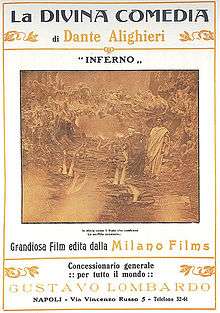L'Inferno
L'Inferno is a 1911 Italian silent film, loosely adapted from Inferno, the first canticle of Dante Alighieri's Divine Comedy. L'Inferno took over three years to make, and was the first full-length Italian feature film.[2]
| L'Inferno | |
|---|---|
 | |
| Directed by |
|
| Based on | The Divine Comedy by Dante Alighieri |
| Starring | Salvatore Papa Arturo Pirovano Giuseppe de Liguoro Augusto Milla |
| Music by | Raffaele Caravaglios (original soundtrack)
Tangerine Dream (2004 DVD) Edison Studio (2011 DVD) |
| Cinematography | Emilio Roncarolo |
Production company | |
| Distributed by | Helios |
Release date |
|
Running time | 68 minutes |
| Country | Italy |
| Language | Silent film |
| Budget | Greater than 100,000 Lire[2] |
Plot
Dante is barred from entering the hill of salvation by three beasts that bar his path (Avarice, Pride and Lust). Beatrice descends from above and asks the poet Virgil to guide Dante through the Nine Circles of Hell. Virgil leads Dante to a cave where they find the river Acheron, over which Charon ferries the souls of the dead into Hell. They also see the three-headed Cerberus, and Geryon, a flying serpent with the face of a man. They see the Devil eating human beings whole, harpies eating the corpses of suicides, an evil man forced to carry his own severed head for eternity, people half buried in flaming lava, etc.
There follows a series of encounters in which the two meet up with a number of formerly famous historical figures whose souls were denied by both Heaven and Hell, and they listen to some of their tales told in flashback. These characters include Homer, Horace, Ovid, Lucanus, Cleopatra, Dido, the Queen of Carthage, the traitor Caiphus, Count Ugalino, Peter of Vigna, Francesca Da Rimini and her lover Paulo, Brutus and Cassius, Mohammed and Helen of Troy. The main attraction of the film are the fantastic set designs depicting the horrors of Hell, with excessive violence and gore, designed to frighten the audience into becoming pious and God-fearing.
Cast
- Salvatore Papa as Dante Alighieri
- Arturo Pirovano as Virgilio
- Giuseppe de Liguoro as Il conte Ugolino
- Augusto Milla as Lucifer
- Attilio Motta
- Emilise Beretta
Production
L'Inferno's depictions of Hell closely followed those in the engravings of Gustave Doré for an edition of the Divine Comedy, which were familiar to an international audience,[2][3] and employed several special effects.[4]
As Dante's Divine Comedy places Muhammad in hell the film also has a momentary unflattering depiction of Muhammad in its Hell sequence (his chest explodes, exposing his entrails).[5]
Nancy Mitford recorded seeing the film in Italy in 1922, referring to it as Dante. She records that it lasted from 9 until 12:15 including two intermissions. She details many of the deaths and tortures from the film. Her description of the film in her letter home is quoted in the biography Nancy Mitford by Harold Acton.[6]
The scenes from Hell from the film were reused in an American 1936 exploitation film Hell-O-Vision and the 1944 race film Go Down, Death![7][8] Some American state film censor boards required removal of the hell sequences from L'Inferno used in Go Down, Death! such as one where a woman's bare breast is momentarily seen.[8]
Release
L'Inferno was first screened in Naples in the Teatro Mercadante on March 10, 1911.[2] An international success, it took in more than $2 million in the United States, where its length gave theater owners an excuse for raising ticket prices.[4]
Home video
For many years, L'Inferno was largely unseen and only available in lower quality, incomplete copies. In 2004, a newly restored version of the film, combining British and American prints from the BFI National Archive and the Library of Congress, was released on UK DVD by the Snapper Music label. It was scored by father and son Edgar and Jerome Froese, of the German electronic band Tangerine Dream. The film has English intertitles and subtitles in German, French, Spanish and Italian. In 2011, L'Inferno's centenary, a brand new and more complete digital restoration by Italy's Cineteca di Bologna was released on their own DVD label. This version has original Italian intertitles, optional English subtitles, and a choice of an electro-acoustic score by Edison Studio or a composition for piano by Marco Dalpane. It also has many extras, including some restored early Italian shorts and a bilingual paperback book.
See also
- Depictions of Muhammad
- Nudity in film
- Inauguration of the Pleasure Dome, a 1954 film by Kenneth Anger that utilizes footage from L'Inferno
References
- Welle, John P. "Early Cinema, Dante's Inferno of 1911, and the Origins of the Italian Film Culture." Dante, Cinema, and Television. Ed. Amilcare A Iannucci. University of Toronto Press, 2004. 36. Book.
- Welle, John P. (2004). "Early Cinima, Dante's Inferno of 1911, and the Origins of Italian Film Culture". In Iannucci, Amilcare A. (ed.). Dante, Cinema, and Television. University of Toronto Press. pp. 36, 38–40. ISBN 0-8020-8827-9.
- Bondanella, Peter (2009). A History of Italian Cinema. New York: Continuum International Publishing Group. p. 7. ISBN 978-1-441-16069-0.
- Braida, Antonella (2007). "Dante's Inferno in the 1900s: From Drama to Film". In Braida, Antonella; Calé, Luisa (eds.). Dante on View: The Reception of Dante in the Visual and Performing Arts. Aldershot, England: Ashgate Publishing. pp. 47–49. ISBN 978-0-7546-5896-2.
- Plate, S. Brent (2006). Blasphemy: Art that Offends. Black Dog. p. 39. ISBN 978-1-9047-7253-8.
- Acton, Harold (2010). Nancy Mitford. Gibson Square. ISBN 978-1-906142-57-5.
- Looney, Dennis (2004). "Spencer Williams and Dante: An African-American Filmmaker at the Gates of Hell". In Iannucci, Amilcare A. (ed.). Dante, Cinema, and Television. University of Toronto Press. pp. 135–36. ISBN 0-8020-8601-2.
- Weisenfeld, Judith (2007). Hollywood Be Thy Name: African American Religion in American Film, 1929-1949. University of California Press. pp. 115–19, 127–28. ISBN 978-0-520-22774-3.
External links
| Wikimedia Commons has media related to L'Inferno (1911 film). |